Now that Apple has finally unveiled most — if not all — of their plans for the Apple Watch lineup including release dates and prices it’s time to make our initial decision. Do you want to dish out the cash for Apple’s premiere smartwatch, or should you wait?
It’s a question that many consumers have been asking for the past couple of years now, especially with all the recent smartwatch releases from manufacturers and brands other than Apple. There are some pretty awesome and amazing choices out there, but is now the time?
Perhaps the biggest question — the one that could answer most of the others — in regards to the Apple Watch is this: what does it do? We’ve been hearing all kinds of speculation about features and functionality for the past year or so, but now we know what the Apple Watch is actually going to do. From the cheapest $349 Sport Edition, to the most expensive $17,000 Apple Watch Edition let’s take a closer look to see what you’re getting for your money.
This is not a review nor a preview, it’s simply a detailed description of officially confirmed Apple Watch features and functionality.
What Is a Smartwatch?
Assuming you don’t know what a smartwatch is, we’ll start from the beginning. If you already do know, you might want to skip this section.
 A smartwatch mimics the function — and often the form — of a traditional wristwatch. Generally, they are made with premium materials and include both a watchface and some manner of wriststrap. They also display the time in several different formats, and therein lies part of the allure of a smartwatch. With a traditional watch, you’re stuck with a single design and watchface style. With a smartwatch, you can swap out your watchface at any time; whether they be digital or analog based.
A smartwatch mimics the function — and often the form — of a traditional wristwatch. Generally, they are made with premium materials and include both a watchface and some manner of wriststrap. They also display the time in several different formats, and therein lies part of the allure of a smartwatch. With a traditional watch, you’re stuck with a single design and watchface style. With a smartwatch, you can swap out your watchface at any time; whether they be digital or analog based.
Of course, smartwatches also offer a great deal of other features and functionality too. Most of the time they are meant to be used as a companion device in combination with your smartphone. They will deliver notifications, alerts and messages on your wrist thus eliminating the need to pull out your phone and check for new content.
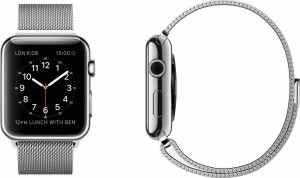 Smartwatches are also capable of tracking fitness activities and data — such as calories burned, or steps taken — and often have tethered access to the internet thanks to integrated Wi-Fi or an active Bluetooth connection. Some can remotely place phone calls or take them, while others are limited. Further yet, some offer voice controls and remote dictation support thanks to platforms like Google Now, and Siri.
Smartwatches are also capable of tracking fitness activities and data — such as calories burned, or steps taken — and often have tethered access to the internet thanks to integrated Wi-Fi or an active Bluetooth connection. Some can remotely place phone calls or take them, while others are limited. Further yet, some offer voice controls and remote dictation support thanks to platforms like Google Now, and Siri.
Some smartwatches (like the Samsung Gear S) are even standalone, which means you can pop in a SIM card, connect to a wireless mobile network and use them in place of a smartphone.
There are many different types of smartwatches, and the Apple Watch just happens to be one of the newer options on the market.
What Is the Apple Watch?
Now that’s out of the way, let’s get to talking about the Apple Watch specifically.
Naturally, the Apple Watch is Apple’s answer to the current wearable craze. It’s designed solely for use with iOS (read: iPhones) devices generation 5 and up. If you’re an iOS user and you’ve been clamoring for a compatible smartwatch for some time, this is your chance (not your first, mind you, but it’s one of the more promising options).
Barring any previous knowledge of smartwatches, what does it do exactly? That’s what we’re going to talk about!
There Are Three Different Apple Watch Models
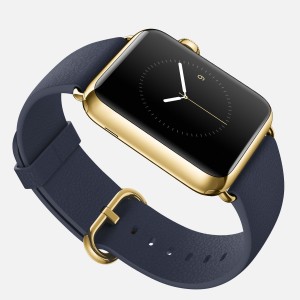 The Apple Watch Sport is comprised of an anodized aluminum case that comes in either silver or space grey. The face — or display — has been designed with Ion-X glass which is supposedly more durable and harder than sapphire. Since it’s designed for those with an active lifestyle — and meant to be worn during exercise — it’s much lighter than the other two models. It also happens to be the cheapest in the lineup, starting at $349 for the 38mm size and maxing out at $399 for the 42mm size.
The Apple Watch Sport is comprised of an anodized aluminum case that comes in either silver or space grey. The face — or display — has been designed with Ion-X glass which is supposedly more durable and harder than sapphire. Since it’s designed for those with an active lifestyle — and meant to be worn during exercise — it’s much lighter than the other two models. It also happens to be the cheapest in the lineup, starting at $349 for the 38mm size and maxing out at $399 for the 42mm size.
The Apple Watch — which seems to be plainly labeled — is comprised of stainless steel, and comes in either a chrome or space black. The touchscreen display is covered in sapphire crystal, which is supposedly much more durable than Gorilla Glass. As for the price, it starts at $549 and maxes out at $1,099 depending on the size (38mm or 42mm) and band style you choose. Obviously, premium metal and stainless steel bands are going to cost more.
Then there’s the Apple Watch Edition, which is the most luxurious and of that there is no question. It’s designed in solid 18-karat gold casing, and comes in either yellow or rose gold. Since it’s made of gold, it also happens to be relatively heavy — much heavier than the other two models. As with the other models, the price varies from $10,000 to $17,000 depending on the size and band style you choose. As an added bonus, it comes bundled in a leather box that can be used as an optional charging cradle, so there’s that.
What Phones Will the Apple Watch Work With?
You’ll need an iPhone to pair up with the Apple Watch — all models — if you want to take advantage of its most promising features. Fortunately, you don’t need to upgrade to the latest generation (iPhone 6 or 6 Plus). The iPhone 5, 5s, or 5c will work just fine with the Apple Watch, if you already own them. If you own an older model, you’ll need to upgrade before you can use one.
What Can the Apple Watch Do?
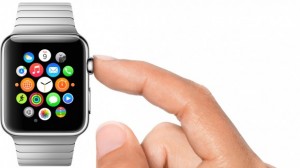 The Apple Watch does include a traditional touchscreen display (Retina) but that’s not how you’re going to be controlling and interacting with it most. Instead, Apple has integrated what they call the “Digital Crown.” In case you don’t already know, the crown is generally the dial on the side of a traditional watch that allows you to set the clock, date or various face readings. However, on the Apple Watch the Digital Crown serves as a mini joystick or mouse nub of sorts. It’s very reminiscent of the iPod’s clockwheel. You can turn the crown to scroll through lists, zoom out of maps or even move through the UI. Pressing the crown in – like a button – will return you to the homescreen just like the home button on an iPhone.
The Apple Watch does include a traditional touchscreen display (Retina) but that’s not how you’re going to be controlling and interacting with it most. Instead, Apple has integrated what they call the “Digital Crown.” In case you don’t already know, the crown is generally the dial on the side of a traditional watch that allows you to set the clock, date or various face readings. However, on the Apple Watch the Digital Crown serves as a mini joystick or mouse nub of sorts. It’s very reminiscent of the iPod’s clockwheel. You can turn the crown to scroll through lists, zoom out of maps or even move through the UI. Pressing the crown in – like a button – will return you to the homescreen just like the home button on an iPhone.
Seated right below the Digital Crown, is a physical button which Apple simply calls “the Button.” Pressing it will open the Friends app, which is essentially going to be the Watch’s version of a contact book. By tapping the picture of a friend in this app, you can send messages, call them via your phone, or send them information using the Apple Watch such as your heart-rate and more (we’ll get to that in a bit).
Of course, you can always use the touchscreen to navigate if you’re so inclined, but it might be difficult if you have large fingers like we do.
It also uses gestures – like swiping – and something Apple calls Force Touch to control. The device can actually distinguish between a regular tap or light touch and a more forceful one. In this way, you’ll be able to use different kinds of taps to interact with the device.
When it comes to hardware sensors, the Apple Watch includes a gyroscope, and an accelerometer. On the rear of the watchface – which will be pressed against your wrist – is a unique sensor that uses visible-light and infrared LEDs in combination with photodiodes to determine heart-rate. In layman’s terms, there’s a heart-rate sensor on the back too.
For wireless connectivity there’s integrated Wi-Fi and Bluetooth to connect with an iPhone. The Apple Watch can use an iPhone’s GPS radio to detect location data.
These sensors work pretty much how you’d expect. The accelerometer allows for steps and distance tracking, among other useful stats. Native Apple Watch apps Activity and Workout will allow you to see fitness goals, progress and stats in realtime. It will also give you feedback on your activity, sort-of like a digital trainer. These apps will sync up with your Health and Fitness apps on your iPhone. In addition, most third party fitness apps will require you to carry your iPhone along, to use GPS or track various stats.
Can the Apple Watch Do Anything Unique?
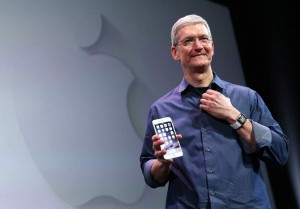 The most unique feature of the Apple Watch is the touted Digital Touch, function. This will allow Apple Watch wearers to wirelessly connect with one another through gestures and device feedback. Wondering what that means? Here’s an example: if you’re running in a local park and you pass by a friend you can send them a quick hello, which essentially vibrates or pulsates their device. In this same manner, you can send hand drawn pictures to one another, heart-rate data, and more.
The most unique feature of the Apple Watch is the touted Digital Touch, function. This will allow Apple Watch wearers to wirelessly connect with one another through gestures and device feedback. Wondering what that means? Here’s an example: if you’re running in a local park and you pass by a friend you can send them a quick hello, which essentially vibrates or pulsates their device. In this same manner, you can send hand drawn pictures to one another, heart-rate data, and more.
It’s a pretty neat feature, though not entirely a necessity. It’s worth noting that the iPhone – even the new models – cannot do this nor will they be able to in the future.
The Apple Watch Includes Siri Voice Control Support
The Apple Watch does include both a microphone and speaker, which means not only can you make and take calls – you can also interact with Siri, the beloved Apple voice control platform. You can do things like set personal reminders, send audio messages and memos, communicate via a walkie-talkie style mode with other Apple Watch wearers, and even ask Siri questions. Yes, all of this can be done directly from the smartwatch, but you will need a paired smartphone.
The Apple Watch Can Be Used to Pay
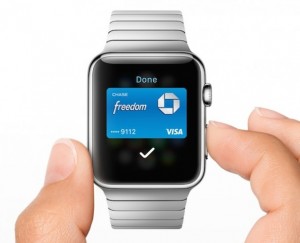 The Apple Watch includes NFC (near-field communication) functionality, which means just like the iPhone 6 and 6 Plus you can use it to pay for goods and services like a credit card. You won’t be able to use this feature just anywhere as the seller must be using NFC-capable equipment too.
The Apple Watch includes NFC (near-field communication) functionality, which means just like the iPhone 6 and 6 Plus you can use it to pay for goods and services like a credit card. You won’t be able to use this feature just anywhere as the seller must be using NFC-capable equipment too.
Of particular note, is the fact that you don’t need one of the newer smartphones to use Apple Pay on the Watch. Even if you have the older iPhone 5, 5c and 5s models you can still take advantage of this feature.
If you take off the Watch, it will lock and requires a passcode to regain entry. For the most part, no one will be able to take your Watch and start paying for goods without your consent.
What About Apple Watch Apps?
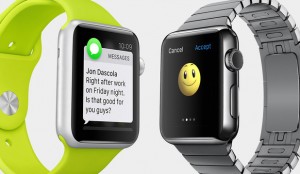 All the native iOS apps are supported at launch including Messages, Mail, Weather, Calendar, Maps, Passbook, Music, Photos, and many more. Unfortunately, it doesn’t include Safari so you won’t be able to browse the web directly, nor does it include its own camera app – or the hardware for it. That said, it does include a remote shutter option that allows you to remotely control your iPhone’s camera.
All the native iOS apps are supported at launch including Messages, Mail, Weather, Calendar, Maps, Passbook, Music, Photos, and many more. Unfortunately, it doesn’t include Safari so you won’t be able to browse the web directly, nor does it include its own camera app – or the hardware for it. That said, it does include a remote shutter option that allows you to remotely control your iPhone’s camera.
For third party apps, the Apple WatchKit SDK has been available since November, 2014 so there should be plenty to choose from. Apple has demoed what apps like Glances, Instagram and Uber will look like on the Watch at various expos and events. We know there will be plenty of similar apps at launch.
Apple Watch Battery Life and Charging Setup
Apple claims the Apple Watch last for a full-day on a single charge, up to 18 hours of both active and passive use. If you’re wondering what that usage scenario includes, here’s the list:
- 90 time checks
- 90 notifications
- 45 minutes of continuous app use
- 30-minute workout with Bluetooth music playback
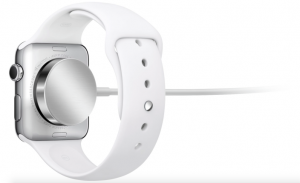 If you use your device a little too much throughout the day and the battery starts to drain fast, it will enter a Power Reserve mode – for up to 72 hours – that allows you to see the time, but you can’t do anything else. We’re sure this mode can be disabled if you don’t care about the battery draining.
If you use your device a little too much throughout the day and the battery starts to drain fast, it will enter a Power Reserve mode – for up to 72 hours – that allows you to see the time, but you can’t do anything else. We’re sure this mode can be disabled if you don’t care about the battery draining.
That said, you’ll need to charge your Apple Watch every night right along with your phone. Apple does claim the batteries are replaceable, though we’re not sure how that will work just yet nor how much a replacement will cost.
When it comes to charging, the rear of the device includes metal charging contacts, and the charging cable will snap and stay in place thanks to magnets. The battery is energized through induction charging, similar to wireless charging methods.
There are no guarantees, but we might see some neat third-party chargers and docks for the Apple Watch eventually.
When Will the Apple Watch Be Available?
The Apple Watch will ship to customers on April 24, but you can pre-order as soon as April 10. It’s also worth noting that Apple stores will have the Apple Watch available to demo and try out on April 10, as well. This will give you time to try the device on, pick out the proper size and choose a preferred style and band.
Speaking of bands, the Apple Watch wristband can be swapped out for a custom one of your choosing. Apple themselves revealed several different band styles that you’ll be able to choose from at launch. The Apple Watch Sport comes with a sweat resistant elastomer in black, white, pink, blue, and lime green. Apple Watch and Apple Watch Edition owners will be able to choose from three leather and two metal straps. The first two leather straps are available in stone, light brown, and bright blue; and pink, brown, and midnight blue respectively. The final leather strap is a classic-buckle in black. Then, for the metal bands you have the stainless steel Link Bracelet and a mesh-style Milanese Loop.
